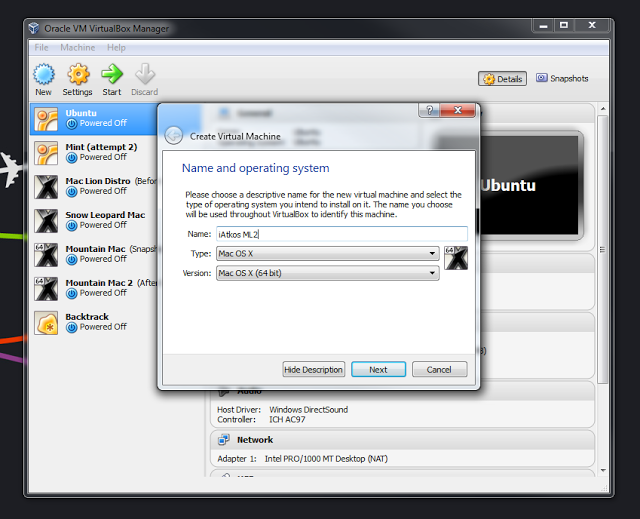- In the Virtual Media Manager, click Add and browse your host file system for the VBoxGuestAdditions.iso file. On a Windows host, this file is in the Oracle VM VirtualBox installation directory, usually in C:Program filesOracleVirtualBox. On Mac OS X hosts, this file is.
- VirtualBox is being actively developed with frequent releases and has an ever growing list of features, supported guest operating systems and platforms it runs on. VirtualBox is a community effort backed by a dedicated company: everyone is encouraged to contribute while Oracle ensures the product always meets professional quality criteria.
Currently MacOS X is available to download for everyone, and with it you will obtain a mass of advantages and bonuses, like incredible Aqua interface and unforgettable style and traditions of classical MacOS X design. However, at the moment all the enthusiasts are capable to install and run MacOS X on VirtualBox VM instance, but you’ve got to know, that you will encounter some obstacles and thorns on your way. The main reason is different hardware architecture, PC has a lot of special options and peculiarities comparing to MacOS X platform, and during installation of MacOS in VirtualBox you will tackle with them all. Also no one guarantees that everything would work fine on your VirtualBox instance, without any problems and barriers, so be ready for unexpected surprises and moments.
In this article I’m going to tell you how to run Mac OS X on VirtualBox, how to customize it and how to transform the virtual instance into functional representation easily.
The first thing what you should do prior to setting up, is to download the virtual hard disk image with the stored copy of Mac OS X (in this build 10.11 ElCaptain version is installed), so everything that you need is to get the installed copy of HDD, import it into VirtualBox and start using it as if you installed it yourself.
First, open VirtualBox and select the newly created install macOS Big Sur virtual machine on the left, then click the ‘Start’ button at the top. Start macOS Big Sur in VirtualBox image 3-b. We will be prompted to ‘Select start-up disk,’ click on the folder icon to the right. Oracle VM VirtualBox Extension Pack. Free for personal, educational or evaluation use under the terms of the VirtualBox Personal Use and Evaluation License on Windows, Mac.
The copy:
https://drive.google.com/drive/folders/0B7cXiM2mdMukRW85U0xxM2FCRFU
So, download the file from the source link and extract the archive to the reliable destination.
Now I will describe the hardware requirements for the MacOS X installation on VirtualBox.
Requirements for the personal computer:
OS: Windows 10/8/7 (64-bit)
CPU: Intel
RAM: 3072 MB (minimal)
BIOS: Virtualization Enable (VT-x)
The next step, which you should perform, is to install VirtualBox.
Further create new VM instance. Here come the parameters:

Name: OSX ElCapitan Final
Type: MacOSX
Version: MacOSX 10.11 ElCapitan (64-bit)
Image: OSX ElCapitan Retail.vmdk
When the form with RAM memory definition appears during VirtualBox setting up, set the RAM size to 4 GB (minimum 2.56 GB).
Next step is related to virtual machine configuration. Set up the following settings for exact reproduction of hardware platform and correct VM operation:
CPU: 2 CPU and Enable PAE/NX
System: Disable Floppy, Enable EFI, Chipset is IHC9 or PIIX3.
On this iteration the algorithm “How to install Mac OS X on VirtualBox?” is approaching to its conclusion. Using the predefined instruction, you will easily be able to install and run MacOSX 10.11 ElCapitan on your Windows PC platform and VirtualBox appropriately and use it with full comfort and coziness. As far as this instruction is quite detailed and circumstantial, you will not feel any discomfort or confusion while addressing to it. Also we checked the links given in the beginning of the article, and may guarantee that they are all correct and working. Thus, they will serve you well and successfully.
Requirement: A Mac desktop or *laptop running OSX, At least 32GB of free drive space (either internal or external). Root access, Windows 10 ISO from uconn.onthehub.com or Microsoft DreamSpark.
*Note: Users with M3 or other dual core processors may experience less than expected performance.
Open a web browser on your Mac.
Go to https://www.virtualbox.org/wiki/Downloads.
Download the latest version of Oracle VirtualBox for OS X hosts.
Go to your Downloads folder and double click on the VirtualBox disk image file (dmg) you just downloaded.
Double click on the VirtualBox.pkg icon.
Click Continue.

Click Continue.
Click Install.
Enter your administrator’s credentials.
Click Install Software.
When the installation completes open your Applications folder.
Install Oracle Virtualbox On Mac
Click on the VirtualBox icon.
How To Install Virtualbox
Related articles
Install Oracle Virtualbox On Macbook
- Page:
- Page:
- Page:
